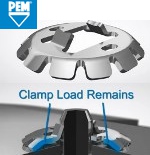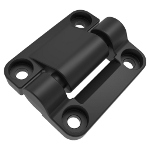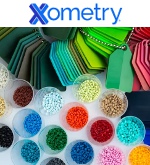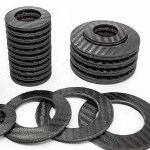 |
| October 03, 2023 | Volume 19 Issue 37 |
Mechanical News & Products
Designfax weekly eMagazine
Archives
Partners
Manufacturing Center
Product Spotlight
Modern Applications News
Metalworking Ideas For
Today's Job Shops
Tooling and Production
Strategies for large
metalworking plants
New 'breathable' rupture disk tech provides overpressure and vacuum relief
 To increase equipment safety and reliability, a new rupture disk technology activates at a set burst pressure, but it can also "breathe" to relieve minor pressure fluctuations. The patent-pending, dual-function device from BS&B Safety Systems is ideal for use on low-pressure vessels that are susceptible to ambient temperature changes.
To increase equipment safety and reliability, a new rupture disk technology activates at a set burst pressure, but it can also "breathe" to relieve minor pressure fluctuations. The patent-pending, dual-function device from BS&B Safety Systems is ideal for use on low-pressure vessels that are susceptible to ambient temperature changes.
Read the full article.
Engineer's Toolbox: 9 considerations for specifying a slewing ring bearing
 In applications that require a bearing to support a structure while it rotates (e.g., cranes, radar, tank turrets), premature bearing failure can put people and equipment at risk. While slewing ring bearings have proven themselves countless times in such applications, designers must consider many factors when specifying them. According to engineers at Kaydon, the bearing's support structure, mounting (including bolt strength, tensioning, and hole patterns), installation, and even storage are all factors in a bearing's success or failure.
In applications that require a bearing to support a structure while it rotates (e.g., cranes, radar, tank turrets), premature bearing failure can put people and equipment at risk. While slewing ring bearings have proven themselves countless times in such applications, designers must consider many factors when specifying them. According to engineers at Kaydon, the bearing's support structure, mounting (including bolt strength, tensioning, and hole patterns), installation, and even storage are all factors in a bearing's success or failure.
Read the full article.
ClampDisk micro fastener is new alternative for automotive and consumer electronics
 Designed as a unique alternative in assemblies for the automotive and consumer electronics markets, the ClampDisk Press-on Fastener is a new offering from PennEngineering that delivers a fast, simple way to achieve sheet-to-sheet clamped fastening while replacing the use of standard screws, nuts, and adhesives. The most common challenges that can be eliminated or reduced by using ClampDisk include over installation, cross threading, stripped screw heads, broken screws, and damaged product. This fastener can be removed easily with a sharp-edged tool.
Designed as a unique alternative in assemblies for the automotive and consumer electronics markets, the ClampDisk Press-on Fastener is a new offering from PennEngineering that delivers a fast, simple way to achieve sheet-to-sheet clamped fastening while replacing the use of standard screws, nuts, and adhesives. The most common challenges that can be eliminated or reduced by using ClampDisk include over installation, cross threading, stripped screw heads, broken screws, and damaged product. This fastener can be removed easily with a sharp-edged tool.
Learn more and see how ClampDisk works.
New nylon constant torque hinge
 Southco has expanded its line of E6 Constant Torque Hinges with a compact, nylon version designed for small applications. The newest addition to the company's E6 50 Constant Torque Position Control Hinge series measures 45 mm with a torque range of 4 to 16 in./lb and is 65% lighter compared to the standard E6 50 Hinge. It provides constant resistance throughout the entire range of motion, enabling users to easily position doors, display screens, and other mounted components and hold them securely at any desired angle.
Southco has expanded its line of E6 Constant Torque Hinges with a compact, nylon version designed for small applications. The newest addition to the company's E6 50 Constant Torque Position Control Hinge series measures 45 mm with a torque range of 4 to 16 in./lb and is 65% lighter compared to the standard E6 50 Hinge. It provides constant resistance throughout the entire range of motion, enabling users to easily position doors, display screens, and other mounted components and hold them securely at any desired angle.
Learn more.
What injection molding material do I use?
 How do you decide what type of plastic to use for your next injection molding project? Xometry can help you narrow your choices. Discover the different strengths and applications for materials that could be ideal for your application by learning about the most common plastic injection molding materials in detail.
How do you decide what type of plastic to use for your next injection molding project? Xometry can help you narrow your choices. Discover the different strengths and applications for materials that could be ideal for your application by learning about the most common plastic injection molding materials in detail.
Read this detailed Xometry article.
What are carbon composite bellows springs?
 The Carbon Composite Bellows Spring (CCBS) from MW Components is a system of carbon fiber elements that combine to work as a high-performance, lightweight, and design-flexible compression spring meant to replace coil springs or metallic Belleville disc springs. A functional spring is made from several individual elements paired and joined to make a stack. The stack spring rate is determined by the number of elements, the base rate of each element, and their series or parallel orientation in the stack. Applications include motorsports, aerospace, and high-performance activities.
The Carbon Composite Bellows Spring (CCBS) from MW Components is a system of carbon fiber elements that combine to work as a high-performance, lightweight, and design-flexible compression spring meant to replace coil springs or metallic Belleville disc springs. A functional spring is made from several individual elements paired and joined to make a stack. The stack spring rate is determined by the number of elements, the base rate of each element, and their series or parallel orientation in the stack. Applications include motorsports, aerospace, and high-performance activities.
Learn more.
Conductive Brush Ring overcomes current leakage in EV powertrains
 SKF's new Conductive Brush Ring paves the way to greater reliability and longer life in high-performance electric vehicle powertrain systems. Using pure carbon fiber bristles, it provides a reliable electrical connection between an EV eAxle rotor shaft and its housing. When used in combination with SKF Hybrid ceramic ball bearings, it helps to alleviate parasitic current effects that can lead to premature failure in bearings and other components. Available in different configurations for wet (oil-lubricated) motor designs -- and soon for dry (sealed) applications.
SKF's new Conductive Brush Ring paves the way to greater reliability and longer life in high-performance electric vehicle powertrain systems. Using pure carbon fiber bristles, it provides a reliable electrical connection between an EV eAxle rotor shaft and its housing. When used in combination with SKF Hybrid ceramic ball bearings, it helps to alleviate parasitic current effects that can lead to premature failure in bearings and other components. Available in different configurations for wet (oil-lubricated) motor designs -- and soon for dry (sealed) applications.
Learn more.
hyperMILL 2024 CAD/CAM software suite
 OPEN MIND Technologies has introduced its latest hyperMILL 2024 CAD/CAM software suite, which includes a range of powerful enhancements to its core toolpath capabilities, as well as new functionality for increased NC programming efficiency in applications ranging from 2.5D machining to 5-axis milling. New and enhanced capabilities include: Optimized Deep Hole Drilling, a new algorithm for 3- and 5-axis Rest Machining, an enhanced path layout for the 3D Plane Machining cycle, better error detection, and much more.
OPEN MIND Technologies has introduced its latest hyperMILL 2024 CAD/CAM software suite, which includes a range of powerful enhancements to its core toolpath capabilities, as well as new functionality for increased NC programming efficiency in applications ranging from 2.5D machining to 5-axis milling. New and enhanced capabilities include: Optimized Deep Hole Drilling, a new algorithm for 3- and 5-axis Rest Machining, an enhanced path layout for the 3D Plane Machining cycle, better error detection, and much more.
Learn more.
One-part epoxy changes from red to clear under UV
 Master Bond UV15RCL is a low-viscosity, cationic-type UV-curing system with a special color-changing feature. The red material changes to clear once exposed to UV light, indicating that there is UV light access across the adhesive material. Although this change in color from red to clear does not indicate a full cure, it does confirm that the UV light has reached the polymer. This epoxy is an excellent electrical insulator. UV15RCL adheres well to metals, glass, ceramics, and many plastics, including acrylics and polycarbonates.
Master Bond UV15RCL is a low-viscosity, cationic-type UV-curing system with a special color-changing feature. The red material changes to clear once exposed to UV light, indicating that there is UV light access across the adhesive material. Although this change in color from red to clear does not indicate a full cure, it does confirm that the UV light has reached the polymer. This epoxy is an excellent electrical insulator. UV15RCL adheres well to metals, glass, ceramics, and many plastics, including acrylics and polycarbonates.
Learn more.
SPIROL Press-N-Lok™ Pin for plastic housings
 The Press-N-Lok™ Pin was designed to permanently retain two plastic components to each other. As the pin is inserted, the plastic backfills into the area around the two opposing barbs, resulting in maximum retention. Assembly time is quicker, and it requires lower assembly equipment costs compared to screws and adhesives -- just Press-N-Lok™!
The Press-N-Lok™ Pin was designed to permanently retain two plastic components to each other. As the pin is inserted, the plastic backfills into the area around the two opposing barbs, resulting in maximum retention. Assembly time is quicker, and it requires lower assembly equipment costs compared to screws and adhesives -- just Press-N-Lok™!
Learn more about the new Press-N-Lok™ Pin.
Why hybrid bearings are becoming the new industry standard
 A combination of steel outer and inner rings with ceramic balls or rollers is giving hybrid bearings unique properties, making them suitable for use in a wide range of modern applications. SKF hybrid bearings make use of silicon nitride (twice as hard as bearing steel) rolling elements and are available as ball bearings, cylindrical roller bearings, and in custom designs. From electric erosion prevention to friction reduction and extended maintenance intervals, learn all about next-gen hybrid bearings.
A combination of steel outer and inner rings with ceramic balls or rollers is giving hybrid bearings unique properties, making them suitable for use in a wide range of modern applications. SKF hybrid bearings make use of silicon nitride (twice as hard as bearing steel) rolling elements and are available as ball bearings, cylindrical roller bearings, and in custom designs. From electric erosion prevention to friction reduction and extended maintenance intervals, learn all about next-gen hybrid bearings.
Read the SKF technical article.
3M and Ansys train engineers on simulating adhesives
 Ansys and 3M have created an advanced simulation training program enabling engineers to enhance the design and sustainability of their products when using tapes and adhesives as part of the design. Simulation enables engineers to validate engineering decisions when analyzing advanced polymeric materials -- especially when bonding components made of different materials. Understand the behavior of adhesives under real-world conditions for accurate modeling and design.
Ansys and 3M have created an advanced simulation training program enabling engineers to enhance the design and sustainability of their products when using tapes and adhesives as part of the design. Simulation enables engineers to validate engineering decisions when analyzing advanced polymeric materials -- especially when bonding components made of different materials. Understand the behavior of adhesives under real-world conditions for accurate modeling and design.
Read this informative Ansys blog.
New FATH T-slotted rail components in black from AutomationDirect
 Automation-Direct has added a wide assortment of black-colored FATH T-slotted hardware components to match their SureFrame black anodized T-slotted rails, including: cube connectors (2D and 3D) and angle connectors, joining plates of many types, brackets, and pivot joints. Also included are foot consoles, linear bearings in silver and black, cam lever brakes, and L-handle brakes. FATH T-slotted hardware components are easy to install, allow for numerous T-slotted structure configurations, and have a 1-year warranty against defects.
Automation-Direct has added a wide assortment of black-colored FATH T-slotted hardware components to match their SureFrame black anodized T-slotted rails, including: cube connectors (2D and 3D) and angle connectors, joining plates of many types, brackets, and pivot joints. Also included are foot consoles, linear bearings in silver and black, cam lever brakes, and L-handle brakes. FATH T-slotted hardware components are easy to install, allow for numerous T-slotted structure configurations, and have a 1-year warranty against defects.
Learn more.
Weird stuff: Moon dust simulant for 3D printing
 Crafted from a lunar regolith simulant, Basalt Moon Dust Filamet™ (not a typo) available from The Virtual Foundry closely mirrors the makeup of lunar regolith found in mare regions of the Moon. It enables users with standard fused filament fabrication (FFF) 3D printers to print with unparalleled realism. Try out your ideas before you go for that big space contract, or help your kid get an A on that special science project.
Crafted from a lunar regolith simulant, Basalt Moon Dust Filamet™ (not a typo) available from The Virtual Foundry closely mirrors the makeup of lunar regolith found in mare regions of the Moon. It enables users with standard fused filament fabrication (FFF) 3D printers to print with unparalleled realism. Try out your ideas before you go for that big space contract, or help your kid get an A on that special science project.
Learn more.
Break the mold with custom injection molding by Rogan
 With 90 years of industry experience, Rogan Corporation possesses the expertise to deliver custom injection molding solutions that set businesses apart. As a low-cost, high-volume solution, injection molding is the most widely used plastics manufacturing process. Rogan processes include single-shot, two-shot, overmolding, and assembly. Elevate your parts with secondary operations: drilling and tapping, hot stamping, special finishes, punch press, gluing, painting, and more.
With 90 years of industry experience, Rogan Corporation possesses the expertise to deliver custom injection molding solutions that set businesses apart. As a low-cost, high-volume solution, injection molding is the most widely used plastics manufacturing process. Rogan processes include single-shot, two-shot, overmolding, and assembly. Elevate your parts with secondary operations: drilling and tapping, hot stamping, special finishes, punch press, gluing, painting, and more.
Learn more.
Some alloys don't change size when heated -- scientists now know why
By Emily Velasco, Caltech
Nearly every material, whether it is solid, liquid, or gas, expands when its temperature goes up and contracts when its temperature goes down. This property, called thermal expansion, makes a hot air balloon float, and the phenomenon has been harnessed to create thermostats that automatically turn a home furnace on and off. Railroads, bridges, and buildings are designed with this property in mind, and they are given room to expand without buckling or breaking on a hot day.
Thermal expansion occurs because a material's atoms vibrate more as its temperature increases. The more its atoms vibrate, the more they push away from their neighboring atoms. As the space between the atoms increases, the density of the material decreases and its overall size increases.

Samples of Invar alloys, which don't change in size and density over a large range of temperatures. [Credit: Brent Fultz lab/Caltech]
There are a few exceptions, but by and large, materials conform strictly to this principle. There is, however, a class of metal alloys called Invars (think invariable), that stubbornly refuse to change in size and density over a large range of temperatures.
"It's almost unheard of to find metals that don't expand," says Stefan Lohaus, a graduate student in materials science and lead author of the new paper. "But in 1895, a physicist discovered by accident that if you combine iron and nickel, each of which has positive thermal expansion, in a certain proportion, you get this material with very unusual behavior."
That anomalous behavior makes these alloys useful in applications where extreme precision is required, such as in the manufacture of parts for clocks, telescopes, and other fine instruments. Until now, no one knew why Invars behave this way. In a new paper published in Nature Physics, researchers from the lab of Brent Fultz, the Barbara and Stanley R. Rawn, Jr., Professor of Materials Science and Applied Physics, say they have figured out the secret to at least one Invar's steadiness.
For over 150 years, scientists have known that thermal expansion is related to entropy, a central concept in thermodynamics. Entropy is a measure of the disorder, such as positions of atoms, in a system. As temperature increases, so does the entropy of a system. This is universally true, so an Invar's unusual behavior must be explained through something counteracting that expansion.
Lohaus says it had been long suspected that this behavior was somehow related to magnetism, because only certain alloys that are ferromagnetic (capable of being magnetized) behave as Invars.
"We decided to look at that because we have this very neat experimental setup that can measure both magnetism and atomic vibrations," Lohaus says. "It was a perfect system for this."
Since the magnetic properties of a material are the result of its electrons' so-called spin state -- a quantum measure of angular momentum that can be either "up" or "down" -- any magnetic effect counteracting the material's expected expansion must be due to the activity of its electrons.
The relationship between entropy, thermal expansion, and pressure, known as the "Maxwell relations," is often presented as a textbook curiosity, but the Caltech group found a way to use it to independently measure the thermal expansion caused by magnetism and by atom vibrations. The experiments were done at the Advanced Photon Source, a source of synchrotron X-rays at the Argonne National Laboratory in Illinois, by measuring the vibrational spectra and magnetism of small samples of Invar at pressures within a diamond anvil cell.
The measurements showed a delicate cancellation of the thermal expansion from atom vibrations and from magnetism. Both changed with temperature and pressure, but in a way that maintained their balance. Using a newly developed accurate theoretical approach, collaborators on this work showed how this balance was helped by interactions between vibrations and magnetism, such as where the frequencies of atom vibrations are altered by magnetism. Such coupling between vibrations and magnetism could be useful for understanding thermal expansion in other magnetic materials, as well for developing materials for magnetic refrigeration.
The experimental setup consisted of a diamond anvil cell, which is essentially two precisely ground diamond tips between which samples of materials can be tightly squeezed. In this case, a small piece of Invar alloy was squeezed at a pressure of 200,000 atmospheres. The researchers passed a powerful beam of X-rays through the alloy, and during that process the X-rays interacted with the vibrations (phonons) of its atoms. That interaction changed the amount of energy carried by the X-rays, allowing the researchers to measure how much the atoms were vibrating.
They also placed sensors around the diamond anvil cell that can detect interference patterns created by the spin state of the electrons belonging to the sample's atoms.
The team used their experimental setup to observe both the atomic vibrations of an Invar sample and the spin state of its electrons as they increased the sample's temperature. At cooler temperatures, more of the Invar's electrons shared the same spin state, causing them to move farther apart and push their parent atoms farther apart as well.
As the temperature of the Invar rose, the spin state of some of those electrons increasingly flipped. As a result, the electrons became more comfortable cozying up to their neighboring electrons. Typically, this would cause the Invar to contract as it warmed up. But here, the Invar's atoms were also vibrating more and taking up more room. The contraction due to changing spin states and the atomic vibration expansion counteracted each other, and the Invar stayed the same size.
"This is exciting because this has been a problem in science for over a hundred years or so," Lohaus says. "There are literally thousands of publications trying to show how magnetism causes contraction, but there was no holistic explanation of the Invar effect."
The paper describing the research, "Thermodynamic explanation of the Invar effect," appears in the July 27 issue of Nature Physics.
Published October 2023
Rate this article
View our terms of use and privacy policy

